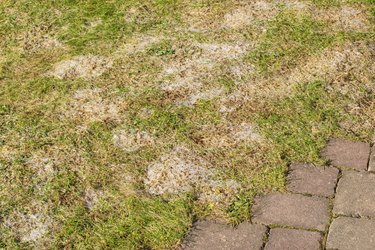
Watch out for internet sites that recommend treating lawn fungus with vinegar because vinegar is considered a "contact" herbicide: It will kill whatever it contacts. This means that spraying it on your lawn in order to treat a lawn disease, such as a fungus, will also kill the grass blades or at least make them die back. If you already have an unsightly fungal infection, you don't want to make it worse by browning your entire lawn.
The best way to treat any of the many fungal infections that can affect lawns is through best practices: Ensure proper sunlight and moisture, aerate your lawn, and regularly treat it for thatch. If these basic maintenance tasks don't result in a healthier lawn, then resort to a fungicide treatment.
Video of the Day
Video of the Day
Fungal Diseases That Impact Grass
Fungal diseases and lawns go hand in hand, unfortunately; in fact, most turfgrass diseases are caused by fungi. The symptoms might be brown patches, spots, threads, diseased rings, or slime. The list of culprits is long but includes fungi that attack the leaves, the crown, or the roots. Among the foliar diseases are powdery mildew, red thread, rust, and downy mildew. Common diseases that attack the crown as well as the leaves are anthracnose, brown patch, leaf spot, red leaf spot, and yellow patch. Finally, diseases that primarily target the roots are dead spot, necrotic ring spot, bermudagrass decline, spring dead spot, and summer patch.
Ouch. With all these fungi roaming around looking for a toe-hold in a healthy lawn, what's a homeowner to do? Well, the first thing is to up your maintenance game because all the fungicides in the world won't eradicate a fungus if the conditions that led to it are not addressed.
Choose Disease-Resistant Cultivars
It may be too late, but if you are just seeding your grass or need to reseed, do some research and plant a disease-resistant variety. Contact the local extension office in your area or local gardening supply stores to identify varieties that work well in your area. The National Turfgrass Evaluation Program is also a great resource.
Perform Regular Maintenance
Shade, humidity, and the wrong moisture levels create a perfect storm for fungal infections in lawns. Another contributor is lawn compaction from heavy traffic to the point that the soil can't hold oxygen.
To avoid heavy fungal infections, first try to increase sunlight penetration. This may entail pruning trees or shrubs. If your lawn is shaded by a nearby building, there's not much you can do about that, although shade-tolerant grass varieties, including fine fescue, tall fescue, or rough bluegrass, can help mitigate the problem. Pruning nearby plants can also help reduce the humidity by improving air circulation.
Monitor your lawn's moisture level. It may be getting too much water, especially in lower or shady areas. On dry days when irrigation is necessary, water in the morning so the grass can dry out during the day.
Perform regular maintenance for general good health. This includes aerating the soil every year or so using a lawn aerator and also dethatching to remove layers of dead grass from the top of the lawn. Both of these maintenance tasks improve soil health so that fertilizer, water, and oxygen can reach your lawn's roots.
When mowing, avoid "scalping" your lawn, which is mowing it too closely. Lawns that are mowed too low are more susceptible to fungal diseases.
Treat With Fungicides
If you are caring for your lawn and performing regular maintenance but you just can't eradicate that fungus, first consider organic treatments, such as neem oil or a baking soda solution. For stubborn diseases, choose an organic fungicide that is specifically designed for your lawn disease.